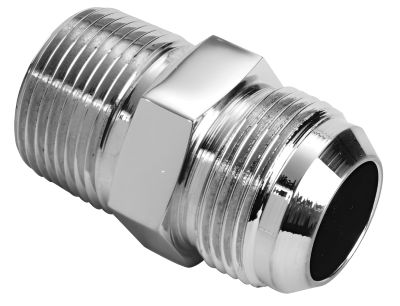Flare fittings are essential components in fluid and gas systems, providing reliable, leak-proof connections in various industries. These fittings work by flaring the end of a tube and securing it with a matching fitting to ensure a tight seal. Two of the most common flare angles are 37-degree and 45-degree, each designed for specific applications.
Understanding the differences between these two types of flare fittings is crucial for ensuring compatibility, safety, and efficiency in your system. This article will compare 37-degree and 45-degree flare fittings, highlighting their key distinctions, industry standards, and best use cases.
What Are Flare Fittings?
Flare fittings are mechanical connectors used to join tubing in fluid and gas systems. By flaring the tube end at a specific angle and using a corresponding flare fitting, a secure and leak-resistant seal is achieved.
How Flare Fittings Work
-
The tubing end is flared at a designated angle (37° or 45°).
-
A corresponding flare nut and fitting are used to create a tight connection.
-
The flared surface forms a seal when compressed against the fitting seat, ensuring leak-proof performance.
Common Materials Used
-
Brass – Common in plumbing and automotive applications.
-
Steel – Often used in high-pressure hydraulic systems.
-
Stainless Steel – Ideal for aerospace, industrial, and high-corrosion environments.
-
Aluminum – Lightweight option for aerospace and racing applications.
Understanding 37-Degree Flare Fittings
37-degree flare fittings are widely used in high-pressure applications, particularly in hydraulic and industrial systems. They are commonly referred to as JIC (Joint Industry Council) fittings or AN (Army-Navy) fittings in aviation and military applications.
Common Applications
-
Hydraulic systems
-
Aerospace and aviation
-
Industrial machinery
-
High-performance automotive (racing, performance fuel systems)
Standards and Specifications
-
JIC 37° flare fittings conform to SAE J514 standards.
-
AN (Army-Navy) fittings follow strict military specifications.
-
Designed to handle high-pressure environments effectively.
Benefits of 37-Degree Flare Fittings
-
Superior performance in high-pressure systems.
-
Compatible with a wide range of industrial and aerospace applications.
-
Made from durable materials like steel and stainless steel.
-
Excellent resistance to vibration and mechanical stress.
Understanding 45-Degree Flare Fittings
45-degree flare fittings are most commonly found in automotive, refrigeration, and plumbing applications. They follow the SAE (Society of Automotive Engineers) standard and are widely used in household and commercial settings.
Common Applications
-
Automotive fuel lines and brake lines
-
Refrigeration and HVAC systems
-
Plumbing systems
-
Medium-pressure fluid applications
Standards and Specifications
-
SAE 45° flare fittings conform to SAE J512 standards.
-
Designed for low-to-medium pressure applications.
-
Commonly made from brass, copper, or steel.
Benefits of 45-Degree Flare Fittings
-
Readily available and widely used in household applications.
-
Suitable for automotive and refrigeration systems.
-
Made from corrosion-resistant materials like brass and copper.
-
Easier to source and install in DIY and repair projects.
Key Differences Between 37-Degree and 45-Degree Flares
|
Feature |
37-Degree Flare |
45-Degree Flare |
|
Angle |
37° |
45° |
|
Industry Standard |
JIC, AN |
SAE |
|
Common Materials |
Steel, stainless steel, aluminum |
Brass, copper, steel |
|
Typical Applications |
High-pressure hydraulic systems, aerospace, industrial |
Automotive, refrigeration, low-to-medium pressure systems |
|
Interchangeability |
Not compatible with 45° fittings |
Not compatible with 37° fittings |
Can You Interchange 37° and 45° Flare Fittings?
No, 37-degree and 45-degree flare fittings are not interchangeable due to their different flare angles. Using the wrong flare fitting can lead to improper sealing, leaks, and potential system failures.
Risks of Using Mismatched Fittings
-
Leaks – The difference in angles prevents a proper seal, leading to fluid or gas leakage.
-
Reduced Structural Integrity – Mismatched fittings can weaken the connection, increasing the risk of failure under pressure.
-
Safety Hazards – In high-pressure or hazardous fluid systems, leaks can pose serious safety risks.
To ensure safety and performance, always use fittings that match the designated flare angle for your system.
Choosing the Right Flare Fitting for Your Application
When selecting between 37-degree and 45-degree flare fittings, consider the following factors:
1. Pressure Rating
-
37-degree fittings are ideal for high-pressure systems (hydraulic, aerospace, industrial machinery).
-
45-degree fittings work well for low-to-medium pressure applications (automotive, refrigeration, plumbing).
2. Material Compatibility
-
Steel & Stainless Steel – Best for high-pressure and industrial applications.
-
Brass & Copper – Common in plumbing, refrigeration, and automotive uses.
-
Aluminum – Lightweight option for aerospace and performance applications.
3. Industry Standards
-
If working with hydraulic and industrial systems, use 37-degree JIC or AN fittings.
-
For automotive and plumbing applications, choose 45-degree SAE fittings.
Tips for a Secure Flare Fitting Connection
-
Always use the correct flare tool for the specified angle.
-
Ensure clean and smooth flares to prevent leaks.
-
Use compatible tubing materials for a proper seal.
-
Tighten fittings to the recommended torque specifications to avoid over-compression.
Conclusion
37-degree and 45-degree flare fittings are both essential in their respective industries, but they serve different purposes and are not interchangeable. Understanding their key differences helps ensure safety, compatibility, and efficiency in fluid and gas systems.
Key Takeaways:
-
37-degree flare fittings are best for high-pressure hydraulic, aerospace, and industrial applications.
-
45-degree flare fittings are commonly used in automotive, plumbing, and refrigeration systems.
-
Interchanging the two types is not recommended due to the angle mismatch, which can lead to leaks and connection failures.
Always check industry standards and specifications before selecting flare fittings to ensure optimal performance and safety in your system.
Post time: Apr-30-2025


